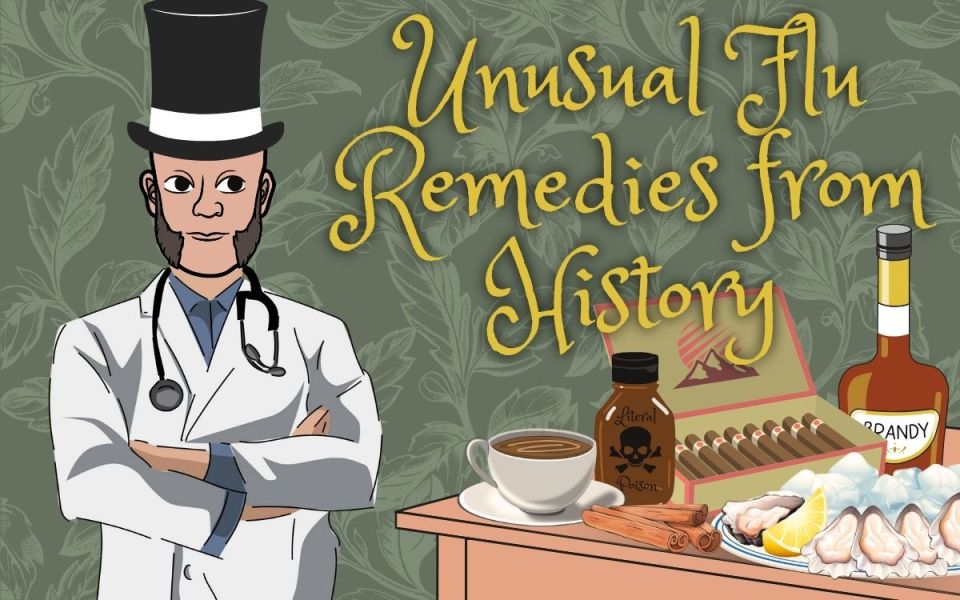The Flu Fighters: Unusual Remedies from History

Cold and flu season is fast approaching, bringing many opportunities to participate in studies for new viral vaccines. The flu, which we now know is caused by the influenza virus, has a long history of baffling physicians, who were often clueless about what causes it. In the 1700s and 1800s, it was called the “gentle correction” or the “jolly rant,” which is wild because it is responsible for more deaths than smallpox, HIV, and all wars combined. Before the modern era, influenza outbreaks would occur in roughly 20 year increments, killing tens of millions of people across affected areas.
Viruses, including influenza, are very tiny pieces of genetic code surrounded by protein. They’re so small that until the 1930’s, there wasn’t a type of microscope that could even see a virus. Influenza travels through the air, and is undetectable by our human senses, so superstition around the disease was astronomical. So astronomical, in fact, that in the 1500s Italians explained the illness as a misalignment of the planets. When faced with an unseeable killer steeped in superstition, people come up with plenty of creative ways to cope, so this week we thought it would be fun to talk about some bizarre historical flu remedies and quirky treatments.
Historically, there was little difference between a prophylactic that prevents a disease and a treatment which is given to help after its onset. Documents recording treatments in America before the industrial revolution are hard to find. By the late 1800s more was written down, and the solutions were wild. “Medical” solutions in the late 1800s and early 1900s for the flu included:
- Heroin and other opioids
- Cinnamon
- Iodine
- Quinine
- Brandy
- Caffeine injections
- Strychnine (a lethal neurotoxin)
- Chloroform
- Hydrochloric acid
- Saline
- Electric shock
Germ theory - the idea that germs cause infectious diseases - was formed in the late 1800s (though viruses were still too small to see) and some “antibacterial” medications for flu also abounded. These included sulfuric or carbolic acid in the nose, eucalyptus, incense, and bacterial vaccines. On top of this was chlorine therapy, where the US Chemical Warfare Service (CWS) pushed the idea that inhaling a chemical weapon might help with the flu.
All of these treatments suffer from the central problem of evaluating flu treatments - that for most people they get better after a few days regardless. Thus, a treatment with no medical value will “miraculously” work in a majority of patients. Things like the chlorine treatment were actually subjected to studies, but without a placebo or control group. Because of this, when patients got better it was attributed to the treatment instead of our awesome immune system. Even worse were treatments and prophylactics that weren’t being pushed in the patients’ best interests. Many commercial treatments and devices were available with no testing, no verification of claims, and no disclosure of ingredients or manufacturing methods. These included gas masks, “medical cigars,” smoke balls, lozenges, portable turkish baths, and medicated wines.
Interestingly, some of the treatments for influenza are still in use today. Salicin, a medication made from willow bark, has been standardized and regulated into aspirin. Doctors frequently prescribed a “good diet” which is always recommended (though the 1800s version of a “good diet” typically included things like beef tea, burgundy with oysters, and few fruits or vegetables). Finally, the most frequently cited recommendations were rest, isolation, and ventilation - all of which are critical to fighting a viral infection and keeping it from spreading. Luckily, these days we have much better microscopes, theories, controlled clinical trials, and methods of fighting viruses like influenza.
Today we fight the flu before we even get it, using vaccines. Vaccines are a way to boost the immune system by letting it prepare for an infection before it's the real deal. With traditional influenza vaccines, scientists replicate the virus (traditionally using chicken eggs) and then weaken or inactivate it. A live attenuated influenza vaccine (LAIV) has a weakened version of the virus that does not cause sickness, but can elicit an immune response. Inactivated flu vaccines use a fully killed virus which can’t replicate at all but still gives the body a chance to detect and develop an immune response, though the immune system may have a weaker response. Similarly, recombinant or subunit vaccines only present parts of the virus, which the immune system detects and builds preparations for. LAIV, recombinant, and inactivated vaccines are all available in the U.S., giving different options for people who have specific medical needs or limitations.
New vaccines are being developed which use mRNA technology. Though the technology behind it is amazing, the principle is basically the same. The mRNA is a “blueprint” (a set of instructions) to create a protein. An mRNA vaccine presents cells with the mRNA blueprint for a part of the virus. Cells make this protein, which is detected by the immune system. This results in a strong immune response. In addition, these vaccines can be modified quickly to respond to new strains of the flu.
Controlled vaccine clinical trials using mRNA technology are enrolling now for the flu season. Beyond mRNA, an even newer class of medication called antiviral conjugates (AVCs) has been developed. AVCs combine mechanisms that stop viruses from reproducing with those that help the immune system clear the virus by targeting specific viral proteins. Controlled clinical trials for this new class of investigational medication are being developed currently. Because of the clinical trial process, if these methods get approved for general use they will have data and science to back them up. They will be included in the “still useful” section instead of the “goofy weird” section of this article when it is rewritten in 2124.
Staff Writer / Editor Benton Lowey-Ball, BS, BFA
Click Below for ENCORE Research Group's Enrolling Studies
References:
Crofton, W. M. (1919). Cause, Prevention, And Treatment Of Influenza. British Medical Journal, 1(3035), 240.
Hampson, A. W. (2008). Vaccines for pandemic influenza. The history of our current vaccines, their limitations and the requirements to deal with a pandemic threat. Annals Academy of Medicine Singapore, 37(6), 510.
Jain, S., Venkataraman, A., Wechsler, M. E., & Peppas, N. A. (2021). Messenger RNA-based vaccines: Past, present, and future directions in the context of the COVID-19 pandemic. Advanced drug delivery reviews, 179, 114000. https://www.sciencedirect.com/science/article/pii/S0169409X21003938
Kidd, C. W. (1935). Treatment of Influenza. The Ulster Medical Journal, 4(2), 87.
Klugman, K. P., Madhi, S. A., Ginsburg, A. S., & Rodgers, G. L. (2018). The role of bacterial vaccines in the prevention of influenza mortality. The Lancet Global Health, 6(12), e1268-e1269. https://www.thelancet.com/journals/langlo/article/PIIS2214-109X(18)30445-5/fulltext
Lansdowne, L.E. (October 14, 2020). Antiviral conjugates – a novel treatment and prevention strategy for viral diseases including COVID-19. Technology Networks. (Website). (Accessed August 8, 2024). https://www.technologynetworks.com/drug-discovery/lists/how-ai-and-machine-learning-can-improve-scientific-data-handling-389910
Loeb, L. (2005). Beating the flu: orthodox and commercial responses to influenza in Britain, 1889–1919. Social History of Medicine, 18(2), 203-224. https://doi.org/10.1093/sochis/hki030
Nader, D., & Marčinko, S. (2007). The Rise and Fall of “Chlorine Chambers” Against Cold and Flu. An Element of Controversy,
Quinn, T. (2016). Flu: A social history of influenza. Fox Chapel Publishing.
Simson, F. T. (1892). On the Treatment of Influenza. British Medical Journal, 1(1621), 171.
Wetmore, F. H. (1919). Treatment of influenza. Canadian Medical Association Journal, 9(12), 1075.
Witte, R., Andriasyan, V., Georgi, F., Yakimovich, A., & Greber, U. F. (2018). Concepts in light microscopy of viruses. Viruses, 10(4), 202. https://www.ncbi.nlm.nih.gov/pmc/articles/PMC5923496/



